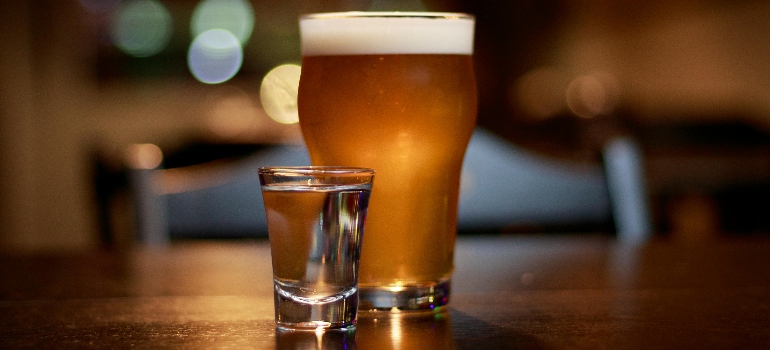How Long Does It Take Alcohol to Leave Your System?
Even if you only drink occasionally, it’s important to know how long does it take alcohol to leave your system. This is because even small amounts of alcohol can negatively affect your health. The time alcohol stays in your body varies from person to person, influenced by factors like age, gender, weight, and the amount and type of alcohol consumed. Being aware of these aspects and alcohol’s overall effects can aid in making healthier choices or seeking help when needed. At Little Creek Recovery, we’ve closely seen how alcohol, from heavy one-time drinking to regular use, can harm both the body and the mind.
Jump to Section
How Does the Body Process Alcohol Through Different Metabolic Pathways?
You may better understand why certain individuals are more vulnerable to alcohol-related problems by understanding how alcohol is metabolized. To put it simply, the length of time it takes for alcohol to leave your body will determine how vulnerable you are to the negative effects of alcohol, both psychological and physical.
The small intestines absorb most of the alcohol consumed, but the bloodstream rapidly absorbs a certain percentage through the stomach. Once in the bloodstream, alcohol goes to the liver, where enzymes process or metabolize the alcohol. The process breaks down alcohol into alcohol molecules, and it has byproducts that can be very dangerous for the body.

In general, there are two pathways a body takes to metabolize alcohol. The first one, and a more typical one, involves the alcohol dehydrogenase (ADH) and aldehyde dehydrogenase (ALDH) enzymes. In two sequential processes, these enzymes break down alcohol into water and carbon dioxide, allowing it to be easily eliminated.
However, if someone consumes alcohol too quickly and in large quantities, the standard pathway is no longer enough. The body then takes an alternative path involving a different set of enzymes. Having this alternative path results in alcohol staying longer in one´s system and, therefore, having a longer impact. Regular drinking can also increase the activity of this second pathway.
How Long Does It Take for Alcohol to Leave Your System?
It might seem like just one glass, but how long does it take for alcohol to leave your system? On average, the liver can metabolize 10 grams, or one ounce, of alcohol per hour. This equals one standard drink per hour.
One standard drink quantity differs for different types of alcohol.
- For normal-strength beer (4% alcohol), one drink means 12 ounces.
- For liquor (40% alcohol), it´s 1.5 ounces, or one shot for drinks like whiskey, vodka, and gin.
- As for the wine, for most of the standard table wines (white, red, rosé, and champagne), one drink equals 5 ounces, while if it´s a fortified wine (the one with more than 13% alcohol), like brandy, cognac, or sherry, one drink equals 3 ounces.
How long does it take for alcohol to leave body will vary based on several factors, and even the same individual may experience different timelines under various circumstances.
- Amount of Alcohol: The more alcohol consumed, the greater the strain on the liver, potentially leading to increased intoxication levels.
- Consumption Rate: Rapid drinking can have a more pronounced negative impact, regardless of the alcohol amount.
- Alcohol Use History: Previous alcohol abuse can affect the body’s current processing capabilities, making it more sensitive to alcohol effects.
- Genetics: Genetic differences can lead to variations in alcohol metabolism; for example, some individuals, due to their genetic makeup, may find it harder to metabolize alcohol.
- Age: Young and older individuals generally have a harder time eliminating alcohol from their system, with age-related factors and medications playing a role.
- Gender: Women often metabolize alcohol more slowly than men, due in part to body composition differences.
- Body Size: Individuals with smaller body frames may feel the effects of alcohol more intensely.
- Overall Health: Good physical condition and pre-drinking eating, or hydration can enhance alcohol metabolism. Existing health conditions can alter how alcohol is processed.
- Medications and Other Substances: Combining alcohol with medications or other substances can affect metabolism and pose additional health risks.

The Impact of Factors on Blood Alcohol Concentration (BAC)
Blood alcohol concentration, or BAC, for short, measures the ratio of alcohol in the blood. A person’s weight and the number of drinks consumed are considered. Gender differences are also part of the equation, and the speed of drinking has an impact.
BAC can have a 0–1 value, with 0 meaning that there´s no alcohol in the system—for example, a BAC value of 0.30 means three parts alcohol for every 1000 parts of blood. A BAC value of 0.45 or higher can be life-threatening.
The more drinks consumed in a shorter period of time, the higher the BAC value. Having food in your stomach helps, so snacking or eating while drinking can positively impact BAC values (with all other factors controlled, BAC can be three times higher for those drinking on an empty stomach). Women tend to have a higher BAC with fewer drinks consumed.
The Effects of Co-consumption With Other Substances
Alcohol use on its own can be harmful, but when combined with other substances, the risk of experiencing negative consequences increases. Typical combinations include tobacco, medicine, and drugs.
Tobacco and alcohol being used together are known to increase the risk of cardiovascular problems as well as the risk of cancers such as gastric and oral cancers. Mixing medicine and alcohol can lead to nausea and vomiting, as well as problems like fainting or loss of coordination. Even alcohol consumption while using over-the-counter medicine can be dangerous.
A frequent occurrence among young adults also involves marijuana and alcohol being used simultaneously. Research reports greater subjective intoxication in those cases, as well as increased danger in comparison to alcohol-only or marijuana-only use. Ingesting even small amounts of alcohol and drugs together intensifies their individual effects and might lead to mental health issues or, in the worst cases, overdose.

The Dangers of Alcohol Consumption
A widely spread recommendation to reduce the risk of alcohol-related issues is to limit one´s consumption to two drinks per day for men and one drink per day for women. Still, newer research implies that any alcohol consumption can be harmful to one´s central nervous system.
Alcohol consumption has both short-term and long-term health risks. Some of the immediate and short-term health risks of binge drinking are injuries, risky sex behavior, violence, and alcohol poisoning.
Long-lasting and continuous alcohol consumption will have more severe consequences and can lead to both physical and mental harm. Some of the chronic and serious physical health issues one might face due to heavy alcohol consumption include heart and liver damage, weakening of the immune system, and cancer. Continuous alcohol use can also lead to social problems related to work and family, as well as problems with learning and memory. Finally, frequent and abundant alcohol consumption might lead to mental disorders like addiction and depression.
Alcohol intoxication occurs due to heavy, acute drinking. It refers to a temporary condition, and its severity is related to the BAC level. Signs of one´s alcohol intoxication are alterations in a person’s consciousness, affect, perception, cognition, judgment, or behavior. According to the National Institute on Alcohol Abuse and Alcoholism, severity ranges from mild to life-threatening.
- Mild intoxication: It occurs when BAC is 0-0.05%, and the initial signs of it are feelings of relaxation and sleepiness. One might also feel a confidence boost and become disinhibited. However, present symptoms also include mild impairments of speech and memory, balance and coordination, and attention.
- Moderate intoxication occurs when the BAC is 0.06–0.15%, and, as a beneficial sign, there´s increased relaxation. However, at this stage, driving skill impairment occurs due to a reduction in responsiveness, alertness, and reaction time. There´s an increased overall risk of injury to the person and people in their environment. All the impairments from the previous stage have increased, and in addition to that, there´s moderate memory impairment and an increased risk of aggression in some people.
- Severe intoxication: When BAC is 0.16–0.30%, the body enters the severe intoxication or alcohol poisoning stage. There are no beneficial signs, and impairments from previous stages are severe. A person can jeopardize others if they are trying to drive. Judgment and reaction time are affected, and there´s a risk of losing consciousness and blackouts.
- Life-threatening intoxication: The name itself implies the severity of this intoxication stage. One enters it when the BAC is 0.31-0.45%. The danger of a life-threatening alcohol overdose is present. One often experiences a loss of consciousness and suppression of vital functions, which pose a significant risk of death. At a BAC of 0.45%, a person is likely to die from alcohol intoxication.
How quickly you reach any of these stages is related to the question of how long does it take for alcohol to leave your system. Although it might seem that a life-threatening stage is difficult to reach, it might happen if a person is drinking at a high speed. The CDC warns that excessive drinking is to blame for 1 in 5 deaths among adults aged 20–49.

Delirium Tremens
Delirium tremens (DT) is a serious form of alcohol withdrawal, and it´s not very common. It occurs within two days of abstinence from alcohol consumption after years of excessive use.
Symptoms of DT manifest in 2–3 days from the last drink. Among the most frequent physical signs are tremors, shaking hands and feet, nausea and vomiting, fever, sensitivity to light, sound, or touch, and seizures. As for psychological signs, common ones are fear, confusion, agitation, severe hyperactivity or sleepiness, and stupor. In some cases, DT might progress to visual alcoholic hallucinations.
Delirium tremens might be rare, but its consequences can be fatal. Anticipated mortality is over 35% without proper treatment. As people suffering from DT experience confusion, their loved ones might need to make informed decisions for them. Treatment for delirium tremens involves medication and professional assistance, such as what we offer at Little Creek Recovery in our alcohol rehab center in Binghamton NY.
Alcoholic Hallucinosis
Alcoholic hallucinosis is a fairly rare consequence of excessive and continuous drinking. It refers to a condition characterized by predominantly auditory hallucinations and related delusional beliefs while remaining oriented and showing no other signs of psychosis. They can be highly distressing and, in extreme cases, lead to suicide.
Practice shows that alcohol psychosis and, with that, hallucinations can occur in cases of acute intoxication, alcohol withdrawal, and chronic alcoholism. Typically, however, alcoholic hallucinations happen to people who´ve been drinking for ten or more years and shortly after reducing or stopping excessive alcohol consumption.
The prognosis is usually good, but in some 10–20% of cases, hallucinations might last longer than six months. The condition might also progress to a chronic form that mimics schizophrenia. In those cases, hospitalization or other types of professional assistance, like alcohol detox, are advised.
Alcoholic Dementia
Long-term, excessive alcohol consumption can lead to a medical condition known as alcohol-related dementia (ARD). This is a type of cognitive impairment characterized by a deteriorating ability to plan, organize, make decisions, and assess risks. Additionally, it might include a reduction of impulse and emotional control, resulting in behavioral issues and mood problems such as apathy, depression, or irritability. Finally, physical balance might be challenged, even when not drinking.
Treatment of alcoholic dementia starts with giving up on drinking, which may induce withdrawal symptoms. One´s medical care team might introduce medication to help with those symptoms or advise joining a support group.
Most commonly affected are men over the age of 45, but ARD can impact both women and men and can occur in younger people as well. Although it’s most often related to long-term alcoholism, it may affect those with frequent episodes of heavy or binge drinking.

The Necessity of Medical Supervision for Treatment
Understanding how long it takes for alcohol to leave the body, along with the challenges of detoxification, highlights the importance of professional assistance. Specialized alcohol rehab centers in Pennsylvania provide a supportive environment for both detoxification and rehabilitation, benefiting not only the person struggling with alcohol but also their family, who may be burdened with care. Individuals facing severe alcohol dependence and addictions gain the most from medical supervision, although treatment options vary based on each patient’s needs.
Resources for Alcohol Detox and Rehabilitation
Finding a reliable place for dealing with alcohol-related issues is essential for success. Those dealing with alcohol-induced conditions need stability and structure in their environment, which is what inpatient rehabilitation centers can provide. Inpatient alcohol rehab in Pennsylvania provides environmental conditions such as 24/7 supervision and medical help when needed.
The initial action involves assisting the body in eliminating alcohol. Following this, further support through participation in support groups and therapy contributes significantly. These activities are designed to help individuals in stopping their alcohol consumption and enhancing their life quality. Often, medical assistance becomes necessary, helping to simplify the detoxification process, provide pain relief, or potentially save lives.

Reach Out to Little Creek Recovery for Guidance and Support in Alcohol Recovery
Knowing how long does it take alcohol to leave your system is vital for grasping and lessening the negative impact of drinking. Recognizing the early signs of alcohol misuse can dramatically affect your life’s quality. Should you or someone close to you face challenges related to alcohol, reaching out for reliable help is a smart move. Our team at Little Creek Recovery is prepared to provide the information, guidance, and inpatient care needed for you or your loved one’s recovery process. Additionally, for those dealing with co-occurring mental health issues and substance abuse, our dual diagnosis treatment center in Pennsylvania offer specialized care. This combined approach of gaining knowledge and seeking professional support is a strong foundation for moving towards a healthier, alcohol-free life.